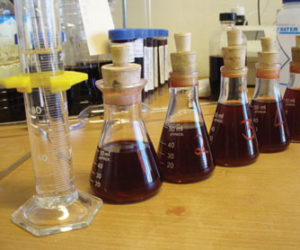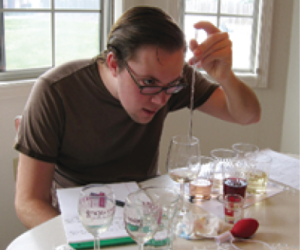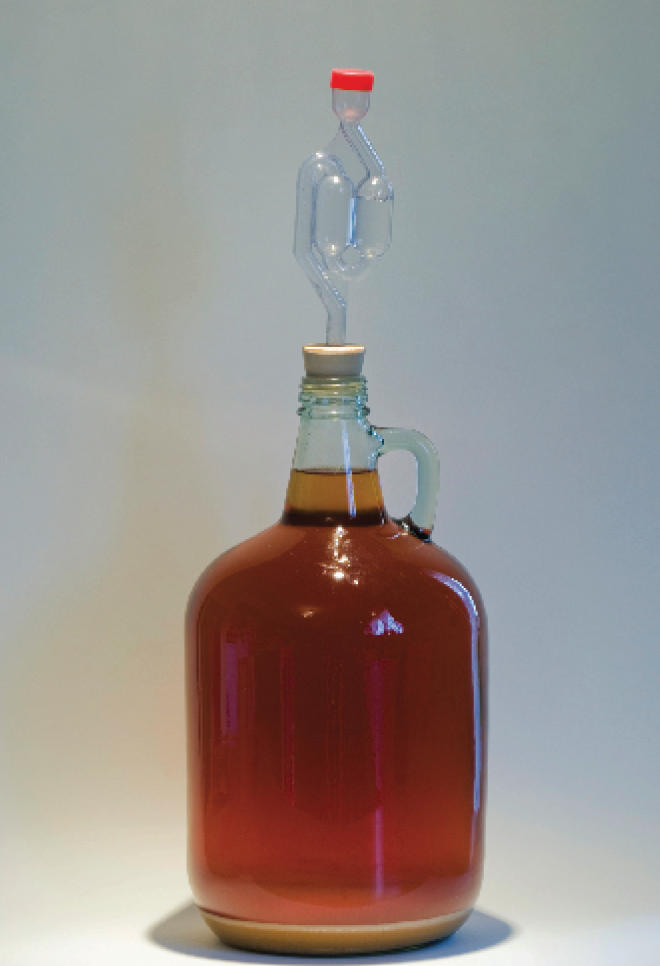
Making wine in small batches, usually from 3 to 5 liters (3 to 5 quarts), is both easier and at the same time more exacting than making wine in much larger batches. Usually the province of country (non-vinifera) wines, Vitis vinifera grapes may also be made in small batches for the harvest of a single grape vine, the harvest of two young vines, or an experimental batch to devise a method for vinification of a new or unusual base, style or technique.
Commercial wineries define small batches differently, and even some home winemakers consider 5 gallons (19 L) as a small batch. For the purpose of this discussion we will adhere to small batches of about a gallon in volume, give or take variations of a liter or so.
Why Small Batches
Small batches are easy on the pocketbook and can be made almost anywhere, especially if space is limited. Apartment dwellers are often forced by circumstance into making small batches. Kitchens of all sizes make perfect work areas for small batch winemaking, and small jugs can easily be hidden from view during fermentation and bulk aging. Persons with physical limitations will usually find small batches easy to manipulate. Beginning winemakers may be more comfortable learning the methods and techniques of their new endeavor by making small batches before scaling upward.
Base ingredient amount dictates batch size. Buying exotic fresh, dried or canned fruit from Thailand, Indonesia, India or South Africa is considerably more affordable when buying 4 to 6 pounds (~ 2 to 3 kg) rather than 20 to 30 pounds (~ 9 to 14 kg). Stashing two exportable but very fresh pineapples in the overhead bin of an airliner when returning home from Hawaii is manageable, while 10 or 12 might entail a logistical hardship.
Similarly, picking 4 to 6 pounds (~ 2 to 3 kg) of blackberries, elderberries, gooseberries, huckleberries, paw-paws or shadberries while on a wilderness hike is not beyond the carrying capacity of a small daypack, but 20 to 30 pounds (~ 9 to 14 kg) might be cumbersome or even impossible to manage. But the fruit of all such encounters can be turned into wine in small batches and should not be ignored. For this reason, hiking in the wilderness with several gallon-size Ziploc bags or similar containers in your daypack is simply a matter of being prepared.
Experimentation also finds small batches conveniently inviting, both from a variable control viewpoint and economic consequence. It is much cheaper and less painful to throw out a bad gallon (1.8 L) than five or more. A 5- or 6-gallon (19- or 23-L) volume can also easily be divided among several smaller jugs to run side-by-side comparisons of yeast strains, temperature variations, tannin extractors, or other variables for future consideration.
The Downside of Small Batches
Small batches of wine are typically expressed in books and other references as recipes. These are comforting to a winemaker who has little idea as to how to proceed with an unusual base. However, winemaking recipes are also potentially misleading. Winemaking recipes are usually based on the experience of their creator. He or she may have made scores of wines of the recipe’s type, or only one. The base he or she used, while identical to the taxa (species, variety, cultivar) the reader might be using, could nonetheless differ in important qualities critical to winemaking — natural sugar content, acidity, tannins and other phenols, pectin, starch, etc. The reasons for this are various.
Even when country wines are made on a commercial or large batch scale, one would have to look long and hard to find such a wine not made with locally grown fruit or berries. This is not necessarily the case with many small batches of wine. While some country wines are made with home-grown bases and others made from locally grown bases from friends, farmers markets or pick-your-own establishments, a great many are made from supermarket fare with no guarantee of source. Supermarket fruit can come from anywhere.
When fruit or berries are harvested for wide distribution — as in the case of grocery stores — they are harvested under-ripe for obvious reasons. For example, ripe plums from Oregon are unlikely to arrive in central Iowa for subsequent distribution in good shape, so the fruit are harvested before they reach optimum ripeness. Under-ripe fruit may travel well, but they can never compare to ripe fruit picked fresh off your own tree or bought from a local farmers market. But of course we know that even local fruit grown and harvested just miles apart can vary in quality.
Terroir, the influence of geography (latitude, altitude, cooler valleys, etc.), geology (soil, substrate, drainage, etc.) and climate (high and low temperatures, dormancy period, annual hours of sunshine, rainfall, etc.), contributes significantly to the quality of fruit, berries and other winemaking bases. Terroir can (and does) vary locally as well as regionally. But, with the widespread import of fruit from different parts of a country, continent, hemisphere, and world there are vast differences in supermarket fruit quality at any given time. This is especially true when these fruit are not in season locally, as then one has little or no clue as to the terroir involved. These factors lead to a downside if one blindly follows winemaking recipes. The odds are remote that your base and the recipe developer’s base are identical in quality or chemistry.
Superficially, another downside to small batch winemaking is a meager four bottles (3-L batch) to six (5-L batch), which disappointingly is never enough when the wine is really, really good. Bottling such wines in 375-mL bottles gives an illusion of more, and with discipline actually does stretch the wine’s enjoyment period. It is surrendering two 750-mL bottles of a small batch to competitions demanding two bottles per entry (“in case one is tainted”) that can really hurt a small-batch winemaker.
On a more substantial note, scaling up small batch recipes, even from one gallon (3.8 L) to three gallons (11 L), often requires some adjustment. Similarly, scaling down a 5- or 6-gallon (19- or 23-L) recipe is more exacting. While this may be slight, it may nonetheless be important and possibly even crucial. We’ll explore some possibilities later in this story.
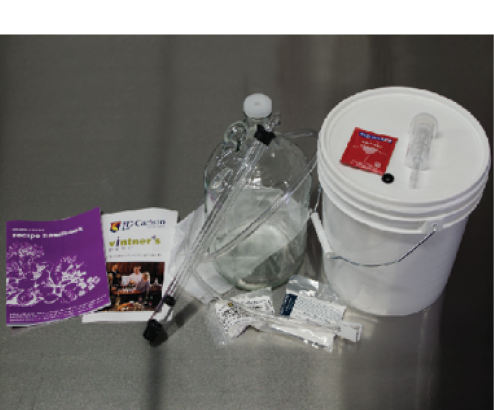
Equipment for Small-Batch Winemaking
Small-batch winemaking does not require a large investment but still requires an initial outlay. Steer clear of advice touting frugal methods of making wine. Your biggest investment in winemaking is time. It would be a shame to waste it using penny-pinching methods that invite bacterial contamination or quick oxidation. An initial investment in dollars will reduce risk to your investment in time.
To make one or more gallon (or 4- to 5-L) size batches of wine you will need, as a minimum, the following:
• 1 appropriate primary fermentation vessel (3-gallon food-grade bucket, crock or glass jar, hereafter simply called a primary)
• 2 glass secondary fermentation vessels (1 containing the liquid and 1 to rack into, hereafter simply called a secondary)
• (1) 5- to 6-foot piece of 3⁄8- or ½-inch diameter clear plastic tubing
• Sediment reduction cap or filter screen for one end of tubing
• Fermentation trap (commonly called an airlock)
• Bung to fit your secondary
• Nylon straining bag (paint filter bags are cheap and readily available)
• Medium to large plastic funnel with sieve
• Hand corker if using corks
• Hydrometer and test cylinder
• Gram scale with 0.1 gram accuracy
This is the minimum one should have to make wine from start to finish. Consider it capital. It can break, wear out or be upgraded, but it is not used up.
There are other pieces of equipment, such as measuring cups, spoons and scales, knives, bowls, pots and pans, that are necessary or required on an occasional to frequent basis, but these probably exist in your kitchen already so need not be acquired just for winemaking.
Expendables for Small- Batch Winemaking
In addition to equipment, there are expendables (supplies). These get used up (although bottles, but not corks, can be recycled). Some possess a shelf life beyond which they are ineffective and have to be replaced periodically.
• Campden tablets or potassium metabisulfite (the latter is best)
• Potassium sorbate
• Acid blend
• Pectic enzyme (powder)
• Grape tannin (powder)
• Yeast nutrient
• Wine yeast
• Wine bottles (screw cap or cork type)
• Bottle closures (screw caps or corks)
Some of the above are chemical additives that degrade over time and must be replaced. For this reason, it is suggested these be purchased in the smallest quantities available commensurate with your usage, usually 1 or 2 ounces, and stored in a dark cabinet. They include the Campden tablets or potassium metabisulfite (18 months) and potassium sorbate (6-8 months). Some liquid pectic enzymes and liquid tannin products degrade over time, especially if not refrigerated, as do some powdered products, especially when exposed to air.
Always read the labels about the shelf life of these products. This isn’t as much of a problem when you are making larger batches and using your inventory more frequently, but if you aren’t making as much wine you should keep an even more careful eye on expiration dates.
Yeast also degrade over time but probably will be used before they expire; yeast should be stored in a refrigerator until 30 to 45 minutes before use. This time can be reduced to a third by placing the packet of active dry yeast in your trouser pocket to warm up. You simply don’t want to add cold yeast to a warm liquid; the yeast may suffer a temperature shock and remain dormant.
There is an ever-growing aversion to adding chemicals to wine. This aversion is largely based on the illogical assumption that because some chemicals are bad then all chemicals are bad. All chemicals used in winemaking are tools that serve specific purposes. Some, such as sulfites, have been used for over two millennium to protect wine and dried fruits from spoilage bacteria and premature browning. Very, very few people have a physiological reaction to the amounts of sulfites used in winemaking. If one can eat raisins without an adverse reaction, one can drink wine containing added sulfites (we say “added” because all wines contain some sulfites produced by yeast). A tablespoon of raisins contains more sulfites than a bottle of wine.
Potassium sorbate can be eliminated in all wines fermented to and bottled at absolute dryness or fortified beyond the yeast’s alcohol toxicity threshold. If a wine contains residual unfermented sugars or if sugar is added to raise its off dryness it should not be bottled “as is.” One could use expensive sterile filtering equipment to remove said yeast, but that is impractical for most home winemakers. Alternatively, adding potassium sorbate to the wine is within everyone’s reach. In wine it converts to its acidic base (sorbic acid) and potassium. The former renders the yeast incapable of reproducing. After adding the sorbate one only has to wait for the majority of surviving yeast to die of old age before bottling “as is” or sweetening and bottling (a little sweetness may intensify flavor, but the key word is “little”). However, the wine is not biologically stable unless also sulfited to an aseptic level (more on this later).
Pectic enzyme (pectinase) is simply an enzyme and is non-reactive to all but pectin, which it neutralizes almost on contact. An elementary understanding of biochemistry should remove any doubts about using pectic enzyme. It will not harm you in prescribed amounts.
Acid blend is a blend of two or more organic acids (usually three) found in plants and their fruit but, except in grapes, rarely in sufficient quantity to allow the fruit’s wine to achieve balance. If you don’t want to buy acid blend (for whatever reason), at least buy tartaric acid. It is the most chemically stable acid winemakers work with.
Grape tannin is a substance that is extracted from the skins and/or seeds of grapes, dried to a powder, and used to supplement inadequate amounts of tannin found in other fruit to levels sufficient to achieve balance.
Generic yeast nutrients (and yeast energizer, when used) contain natural but concentrated nutrients deficient in most fruit. Without these nutrients most non-vinifera wines could not be made with sufficient levels of alcohol to be self-preserving. Never be without yeast nutrients, whether generic or brand name.
Do not avoid winemaking additives due to some misguided notion that all chemical additives are bad. We winemakers need them to make wine that achieves a balance among sugar, alcohol, acid, tannin, and body. Embrace the tools available to you and make good wine.
Nice-to-Have Winemaking Stuff
There will come a time when you know you should add sulfites to the wine but really want to add just enough to maintain an aseptic state. This is when a sulfite test kit is essential, even for a small batch. Once the residual sulfite is measured, calculate the amount to add using a sulfite calculator like the one found here on the WineMaker website.
Certain fruit and yeast have extra nutritional needs, most commonly for nitrogen. A small amount of dissolved yeast energizer or dried yeast hulls will usually do the trick, but a better solution is to buy Fermaid K, a reliable, blended, complex yeast nutrient added in very small amounts (0.5 grams per gallon or 4-L batch) just after the lag-phase of yeast (6–12 hours after inoculation) and again when about 1⁄3 of the sugar has been depleted. Measuring such small amounts requires a gram scale with 0.1 gram accuracy. The smaller the batch the more exacting the measurement must be.
The ability to test and adjust acidity, both as titratable acidity (TA) and acid strength measured logarithmically as the potential of hydrogen (pH), is almost as critical as being able to measure and adjust sugar content. TA is the sum of all organic acids in the must and is expressed in the US as a standard of grams per 100 milliliters (or as a percentage) of tartaric acid. Most wines find balance between 0.5-0.8% TA but higher acidity can be balanced with sweetness. A simple, inexpensive acid titration test kit is used to obtain a must’s TA. Measuring acid to add to a must is more exacting for smaller batches than larger ones and a gram scale is very helpful.
A wine’s pH is measured with a pH meter. Until you can afford a pH meter you can get by using pH testing strips (litmus paper) but be forewarned: they are not as accurate as desired and can be misleading. After a gram scale, a pH meter is the next most important piece of equipment to purchase. An acid test kit, although significantly cheaper than a pH meter, is less critical — your taste buds will tell you if a must is flat and lifeless (usually above 4.0 pH) and needs acid or tart-sour (usually below 3.0 pH) and needs buffering. Anything in between is acceptable but may not achieve optimal balance (3.4-3.6 pH is considered the magic window).
A sanitizing agent is desirable for sanitizing primary and secondary, bottles, bungs, racking hose, airlocks, hydrometer, etc. before use. This extra expense can be avoided by making and using a sanitizing sulfite solution — add 1 teaspoon of potassium metabisulfite to one gallon (3.8-L) of water, soak equipment for at least two minutes, no need to rinse. Use in an open or breeze-through space, as the fumes are noxious. Do not use at this strength if you have asthma or COPD; use B-Brite instead according to its directions, but rinse well after using.
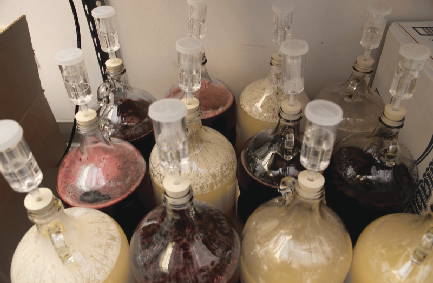
Winemaking Recipes
Small batch winemaking is almost analogous to cooking. One can follow recipes and the meal or entrée will usually turn out well, or one can be a chef and just make a dish from scratch because one knows how ingredients interact and can combine them intuitively. Most of us are cooks, not chefs. We can make a salad or sandwich on the fly but need a recipe if making something we are less familiar with, like shrimp rémoulade, trout amandine or crawfish étouffée.
If we concede that any base we are not very familiar with, perhaps mayhaw, kiwifruit or shadberry, might be analogous to shrimp rémoulade, trout amandine or crawfish étouffée we probably would appreciate having a recipe to guide us in making either. There are two things to consider here.
First, as I mentioned earlier in this story, the odds are remote that your base and the recipe developer’s base are identical in quality. In an effort to come as close to perfection as we can, it is helpful if we can control or manipulate variables.
Flavor is all-important. When several kiwifruit varieties are available and you want to make kiwifruit wine, buy just one of each variety and eat a slice of each. Then go back and buy the most flavorful variety in the quantity specified in the recipe. This holds true for peaches, nectarines, plums and most other more common fruit.
Second, wine recipes are guidelines, not absolutes. After a non-sweetened must is prepared, use your hydrometer to calculate how much sugar to add to achieve, say, 12% alcohol by volume or whatever is required for the style desired. If you have the equipment to test acidity, do it and adjust according to what the real numbers are, not by what the recipe says. Your numbers may echo the recipe’s numbers, but more likely than not they will vary slightly. Slight variations in small batches can be significant to the quality of the finished wine.
Go Small
Making wine in small batches is within the means of anyone. The initial investment in equipment is not budget-shattering but nonetheless required. Use the additives I specified earlier and remember to replace them periodically and watch the expiration dates. Measure the variables as accurately as you can and then adjust them with as much exactness as your equipment allows. Add some of the “nice-to-have” pieces of equipment as your budget permits.
Think about winemaking when you shop. If you find a glass gallon (3.8 L) jug of apple juice, buy it — not only for the glass secondary but because you can turn the juice into a small batch of apple wine. Do not be afraid to try new wines on a small scale. Apple wine recipes using store-bought juice are readily available on the Internet, as are hundreds of other small-batch country wine recipes.
Small batch winemaking opens a world of possibilities to enjoy with minimal expense. Explore!



